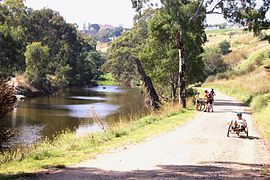Avondale Heights
|
Avondale Heights Melbourne, Victoria |
|||||||||||||
|---|---|---|---|---|---|---|---|---|---|---|---|---|---|

Cycling beside the Maribyrnong River at Avondale Heights
|
|||||||||||||
| Coordinates | 37°45′43″S 144°51′47″E / 37.762°S 144.863°ECoordinates: 37°45′43″S 144°51′47″E / 37.762°S 144.863°E | ||||||||||||
| Population | 10,990 (2011) | ||||||||||||
| • Density | 2,035/km2 (5,270/sq mi) | ||||||||||||
| Postcode(s) | 3034 | ||||||||||||
| Area | 5.4 km2 (2.1 sq mi) | ||||||||||||
| Location | 12 km (7 mi) from Melbourne | ||||||||||||
| LGA(s) | City of Moonee Valley | ||||||||||||
| State electorate(s) | Niddrie | ||||||||||||
| Federal Division(s) | Maribyrnong | ||||||||||||
|
|||||||||||||
Avondale Heights is a suburb 12 km north-west of Melbourne, Victoria, Australia. Its local government area is the City of Moonee Valley. At the 2011 Census, Avondale Heights had a population of 10,990.
Avondale Heights is located on a plateau bounded by a large bend of the Maribyrnong River to the east, south, and west, and to the north by Buckley Street.
The suburb derives its name from the Avondale Estate. Originally known as Maribyrnong West, when the Council undertook to change the name, postal authorities drew attention to the existence of Avondale in Queensland. The suburb was therefore called Avondale Heights to distinguish it from the Queensland town.
Walter Burley Griffin and Marion Mahony Griffin prepared plans for part of the area: Milleara Estate in the north (also known as City View) in the 1920s. One objective of their design was to remake suburbia and society. They did this through creating internal gardens where communities could both physical and socially bind together. They imagined children's playgrounds, social centres, nature reserves and links with an intricate system of pedestrian ways. Interviewed in Melbourne in 1913, Griffin spoke of internal reserves as;
'…favourite playgrounds. Here all the children from the different houses can play together, where their mothers can see them, and where they are safe from the motor traffic in the streets.'
The streets are designed in a curvilinear way typical of the Griffin's design, often following the topography of the land.
There is only one main road - Military Road which runs from Canning Street and Maribyrnong Road, then becoming Milleara Road. There are about 40 shops at the Canning Street end (including Raglan street) and 20 at the other end, near the St Martin De Porres Primary School.
Prior to European colonisation of Melbourne, the Wurundjeri Aboriginal people of the Kulin nation moved through the area. Evidence has been found of human occupation for at least 18,000 years. On 10 October 1940, Mr. James White dug up an ancient human skull, (now known as the Keilor Cranium) on the banks of the Maribyrnong River. This skull has been found to be more than 8,000 years and less than 15,800 years old.
...
Wikipedia

